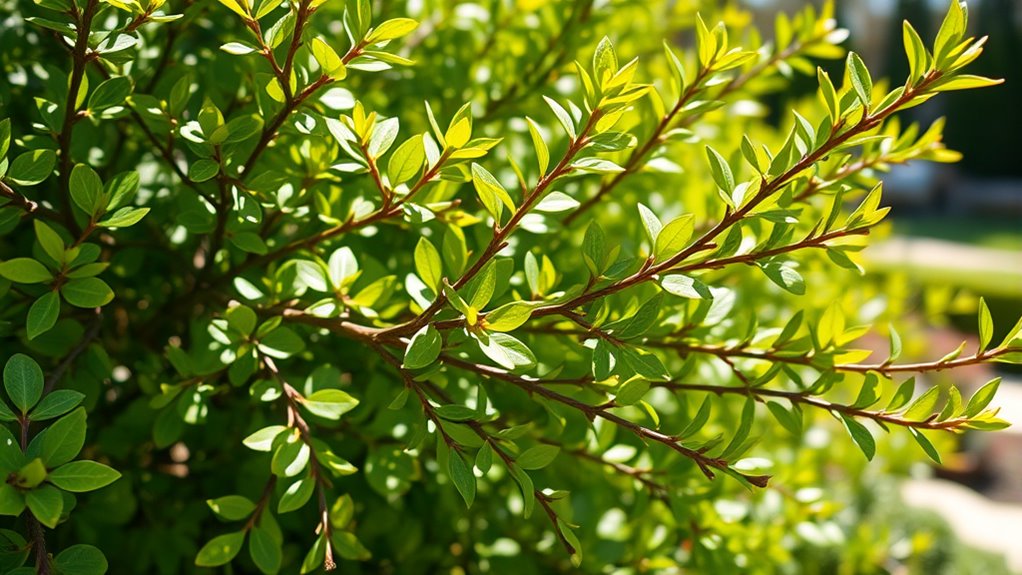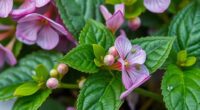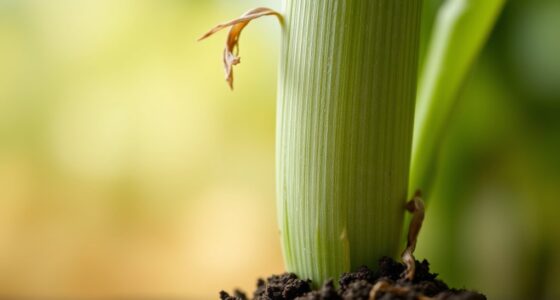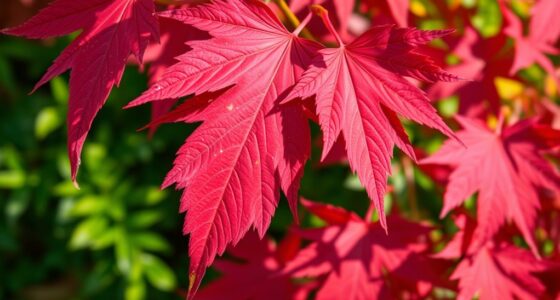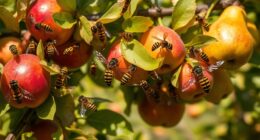Thinning in your Sunshine Ligustrum can occur due to environmental stress, pests, or overgrowth, which weakens its health and shape. Recognizing signs like sparse foliage, dense clusters, or weighed-down branches helps you decide when to prune. Proper rejuvenation involves timing your pruning during active growth seasons and using sharp tools to remove overcrowded, dead, or diseased branches. If you follow these tips, you’ll support your shrub’s vigor and appearance—stick around to learn more about effective pruning techniques and care strategies.
Key Takeaways
- Thinning occurs due to environmental stress, pests, or overcrowded branches that block light and airflow.
- Rejuvenation pruning is best done in spring or early summer to promote healthy regrowth.
- Use sharp, clean tools to remove dead, diseased, crossing, or inward-growing branches for improved structure.
- Post-pruning care includes fertilizing, watering appropriately, mulching, and monitoring for pests.
- Consult professionals if the shrub has extensive damage, persistent pests, or complex pruning needs.
Common Causes of Thinning in Sunshine Ligustrum
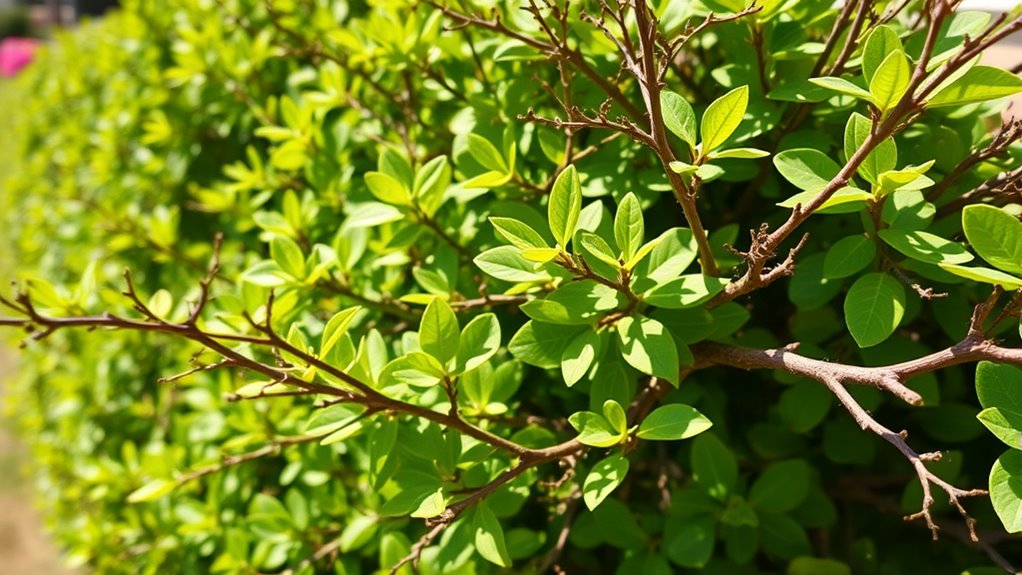
Thinning in Sunshine Ligustrum often results from environmental stress or pests. One common cause is fertilizer deficiencies, which weaken the plant’s overall health and cause sparse foliage. Without proper nutrients like nitrogen, phosphorus, and potassium, the plant struggles to produce healthy, dense growth. Pest infestations also play a significant role; insects such as aphids, scale, or spider mites feed on leaves and sap, leading to leaf loss and thinning branches. These pests damage the plant’s ability to photosynthesize effectively, further weakening it. Environmental factors like drought, poor soil drainage, or extreme temperatures can compound these issues, stressing the plant and making it more vulnerable to pests and deficiencies. Addressing these causes promptly helps restore your Sunshine Ligustrum’s health and fullness.
Recognizing the Signs of Overgrowth and Density

When your Sunshine Ligustrum begins to fill out and expand beyond its usual shape, it’s a clear sign of overgrowth and increased density. You’ll notice the shrub becoming crowded, with less airflow and light penetration. Dense foliage can hinder pruning aesthetics, making the shrub look unruly. Look for signs like overlapping branches, inward growth, and a lack of visible structure. If the plant seems weighed down or overly dense, it’s time to contemplate thinning. Proper pruning restores shrub aesthetics, improves health, and encourages healthy growth. Recognizing these signs early helps prevent overgrowth from becoming unmanageable. Here’s a quick guide:
| Sign to Watch For | Effect on Pruning | Impact on Aesthetics |
|---|---|---|
| Overcrowded branches | Difficult to shape | Ruined shrub aesthetics |
| Reduced light | Poor airflow | Loss of visual appeal |
| Inward growth | Weakens structure | Unkempt appearance |
| Dense foliage | Hard to prune | Less attractive |
| Weighed-down branches | Increased risk of damage | Reduced beauty |
Additionally, understanding the growth patterns of Sunshine Ligustrum can help in planning effective rejuvenation pruning, especially considering its tendency for overgrowth if not maintained regularly. Properly managing growth requires awareness of the plant’s natural growth cycle, which influences how and when to prune for optimal health and appearance.
The Importance of Timing in Rejuvenation Pruning

Timing is crucial for successful rejuvenation pruning of your Sunshine Ligustrum, as performing the right cuts at the appropriate time guarantees healthy regrowth and maintains its aesthetic appeal. Understanding seasonal timing ensures you trim when the plant is most receptive to recovery, typically during its active growth cycle in spring or early summer. Pruning too early or late can stress the plant or hinder new growth. By aligning your pruning schedule with the plant’s natural growth cycle, you give it the best chance to recover quickly and produce vibrant, healthy foliage. Monitoring the plant’s overall health and environmental conditions helps you determine the essential timing. Proper timing maximizes the benefits of rejuvenation pruning and supports the long-term vitality of your Sunshine Ligustrum. Additionally, considering the growth cycle of the plant can help optimize pruning efforts for better results. Recognizing the plant’s dormant period can further improve the success of your rejuvenation efforts, as pruning during dormancy minimizes stress and encourages vigorous growth when the season changes.
Step-by-Step Guide to Proper Thinning Techniques
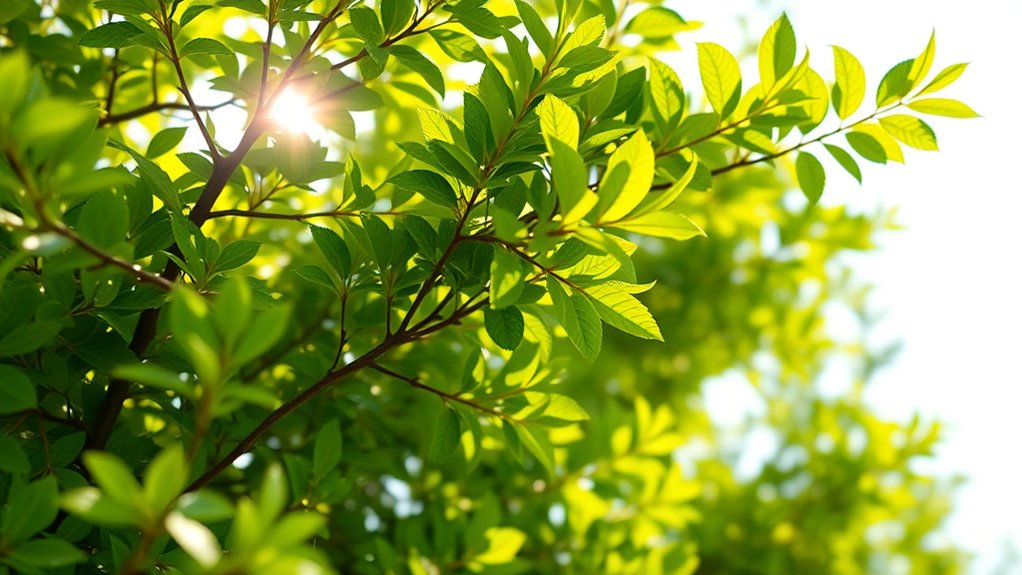
Start by choosing the right tools, like sharp pruning shears or loppers, to make clean cuts. Next, identify the branches that need thinning, focusing on those that are crowded or crossing. Additionally, understanding automation in business can help you streamline your gardening tasks with modern tools and techniques. Incorporating sound healing science principles can also motivate you to create a peaceful gardening environment that promotes relaxation. Finally, prune carefully, making precise cuts to maintain the plant’s shape and health. Incorporating proper financial management techniques can help ensure your gardening projects stay within budget and are sustainable over time.
Select Suitable Tools
Choosing the right tools is vital for thinning your Sunshine Ligustrum effectively and safely. Sharp, clean pruning tools ensure precise cuts and reduce plant stress. Select pruning tools like bypass pruners for small branches, loppers for thicker stems, and pruning saws for larger limbs. Remember, tool maintenance is indispensable—clean your tools after each use to prevent disease spread and keep blades sharp for smooth cuts. Using dull or improper tools can damage the plant and make thinning more difficult. Here’s a quick guide:
| Tool Type | Ideal Use | Maintenance Tips |
|---|---|---|
| Bypass pruners | Fine, precise cuts | Clean and sharpen regularly |
| Loppers | Medium branches | Oil hinges, keep blades sharp |
| Pruning saws | Large branches | Clear debris after use |
Additionally, maintaining optimal pruning techniques ensures healthy plant growth and a more attractive appearance. Choosing the right pruning tools and maintaining them ensures safe, effective thinning.
Identify Thinning Targets
Before you begin thinning your Sunshine Ligustrum, it is essential to identify which branches to remove. Focus on branches that disrupt the plant’s overall shape or hinder light penetration, as this benefits both flower arrangement and pest management. Remove crossing or rubbing branches that can cause wounds or weaken the plant’s structure. Look for diseased or damaged wood to cut back, preventing pests and diseases from spreading. Thin out crowded areas to improve airflow and reduce pest hideouts. Target older, less productive stems that no longer flower well, encouraging new growth. Clear out any dead or weak branches, which can compromise the plant’s health. Properly selecting thinning targets ensures your Sunshine Ligustrum remains healthy, vibrant, and easier to maintain. Additionally, understanding patch testing can help you assess how your plant responds to pruning cuts and treatments, ensuring optimal recovery and health. Incorporating proper pruning techniques promotes vigorous growth and helps maintain the desired shape of your shrub.
Execute Pruning Carefully
When pruning your Sunshine Ligustrum, it’s essential to work carefully to avoid damaging the plant. Prioritize pruning safety by using sharp tools and making clean cuts. Focus on maintaining pruning aesthetics by removing only the necessary branches. To execute proper thinning:
- Identify and target weak or crossing branches for removal
- Cut just above a healthy node to promote new growth
- Avoid removing more than one-third of the plant at a time
- Use clean, sharp tools to prevent tearing or disease transmission
- Consider how remote hackathons can foster innovative ideas for plant care or gardening technology that could benefit future pruning techniques
- Remember that early parenthood involves nurturing and patience, similar to caring for your garden, ensuring that your efforts lead to healthy growth
- Incorporating proper pruning techniques can significantly improve the overall health and appearance of your shrub.
This careful approach guarantees your Ligustrum stays healthy and attractive. Be patient, and take your time during each cut. Proper execution minimizes stress on the plant and enhances its overall appearance. Your attention to detail during thinning results in a vibrant, well-shaped shrub.
Tools Needed for Effective Pruning
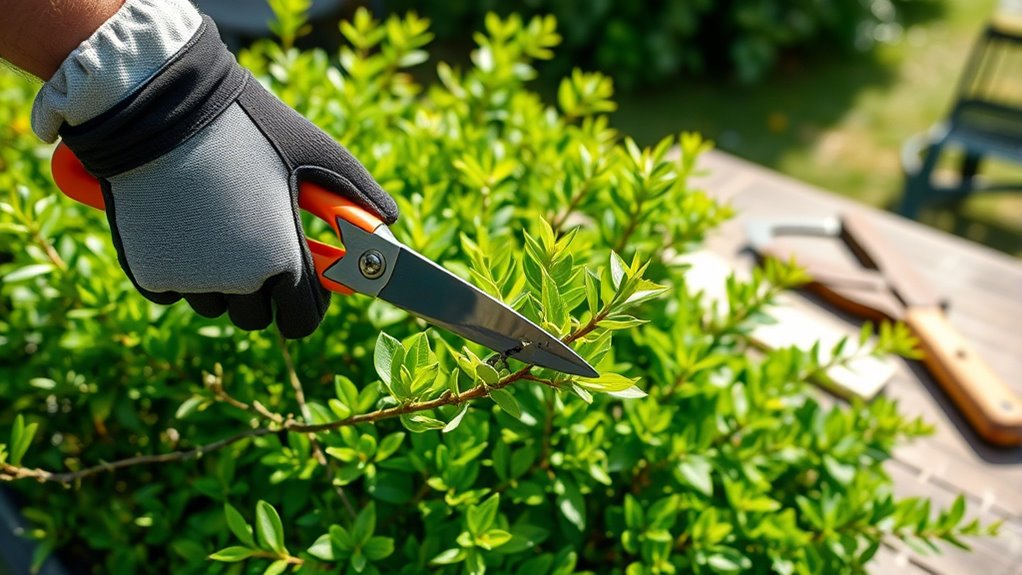
To prune your Sunshine Ligustrum effectively, you’ll need a few essential tools that make the job easier and safer. Sharp pruning shears are vital for clean cuts, reducing plant stress and preventing disease. A pruning saw comes in handy for thicker branches that shears can’t handle. Use gloves to protect your hands from sharp tools and plant irritants. Always keep your tools well-maintained—clean and sharpened—to guarantee pruning safety and efficient cuts. Dull tools can damage branches and increase the risk of injury. A pruning ladder may be necessary for taller plants, providing stability and reach. Proper pruning techniques also help ensure your plant’s long-term vitality and aesthetic appeal. Incorporating data-driven strategies to assess your plant’s health can further guide your pruning decisions and promote robust growth. By choosing the right tools and maintaining them properly, you’ll make pruning safer, easier, and more effective, promoting healthier growth for your Sunshine Ligustrum.
How to Encourage Healthy Growth After Thinning

After thinning your Sunshine Ligustrum, it’s important to focus on nurturing its remaining branches to promote vigorous, healthy growth. Proper care encourages strong development and keeps your shrub vibrant. You should:
After pruning, nurture your Sunshine Ligustrum with balanced fertilization, proper watering, and gentle shaping for vibrant growth.
- Apply fertilizer evenly, using a balanced fertilizer to supply essential nutrients.
- Adjust your watering schedule to keep the soil consistently moist but not waterlogged.
- Mulch around the base to retain moisture and regulate soil temperature.
- Prune lightly to shape the plant and remove any weak or damaged branches.
- Ensure proper divorce process understanding to maintain a healthy environment for your plant, as stress from environmental changes can impact growth.
- Additionally, understanding electric bike conversion kits can help you maintain your gardening tools and equipment for efficient care, especially if you use electric tools or vehicles in your gardening routine.
- Regularly check your soil’s filtration system to ensure the nutrients and moisture levels remain optimal for healthy root development.
These steps help establish a solid foundation for healthy growth. Regular fertilizer application ensures your shrub gets the nutrients it needs, while a proper watering schedule prevents stress. Consistent care boosts recovery and encourages lush, full foliage.
Preventative Measures to Maintain a Vibrant Shrub

Maintaining a vibrant Sunshine Ligustrum requires proactive measures to prevent common issues before they arise. Start with soil improvement by ensuring your soil is well-draining and rich in nutrients, which promotes healthy root development. Regularly test soil pH and amend as needed to keep conditions ideal. Implement pest management strategies by inspecting your shrub frequently for signs of pests like aphids or scale insects. Use appropriate organic or chemical controls promptly to prevent infestations from spreading. Keep the area around your shrub clean and free of debris to reduce pest hiding spots. Proper watering, fertilizing, and pruning also strengthen your plant’s resilience. By combining soil improvement with vigilant pest management, you’ll help ensure your Sunshine Ligustrum remains healthy, vibrant, and less prone to problems.
When to Seek Professional Assistance for Pruning

While regular pruning can often be managed on your own, certain situations call for professional expertise. If you notice complex issues affecting your Sunshine Ligustrum’s health or appearance, it’s time to seek help. Professionals can address aesthetic considerations, ensuring your shrub maintains its shape and beauty. They also excel in pest management, removing infestations that could worsen with improper pruning. Consider contacting a specialist if:
When complex issues arise, consult a professional for expert pruning and pest control.
- The shrub has dead or diseased branches beyond your skill level
- You’re unsure about the correct pruning technique
- You observe persistent pest problems
- The plant’s growth looks uneven or overgrown, impacting its overall look
Professional pruning ensures your Sunshine Ligustrum stays healthy, attractive, and pest-free, saving you time and preventing potential damage.
Frequently Asked Questions
How Often Should Sunshine Ligustrum Be Pruned for Optimal Health?
You should prune your Sunshine Ligustrum about twice a year for ideal health. Establishing a regular pruning schedule helps with growth maintenance, encourages dense foliage, and keeps the plant looking its best. Trim lightly in early spring to shape it and remove dead or overgrown branches in late summer. Consistent pruning prevents overgrowth, improves air circulation, and promotes vibrant, healthy growth throughout the season.
Can Thinning Cause Long-Term Damage to Sunshine Ligustrum?
Thinning your Sunshine Ligustrum is like giving it a spa day, but if you’re not careful, it can lead to long-term damage. Excessive thinning may cause root damage and weaken its structural integrity, leaving it vulnerable to pests and disease. Proper, targeted pruning helps maintain its health without harming the plant. Always prune with care, ensuring you don’t remove too much at once, so your shrub stays strong and vibrant.
What Are the Signs of Improper Pruning in Sunshine Ligustrum?
You’ll notice improper pruning in your sunshine ligustrum through poor growth indicators, like sparse or uneven foliage, and overgrown or bare patches. Common pruning mistakes include cutting too deeply into old wood, which can hinder new growth, or removing too much at once, stressing the plant. If you see these signs, it’s time to reassess your pruning technique to promote healthy, balanced growth and avoid long-term damage.
Are There Specific Fertilizers to Promote Growth After Thinning?
You should choose fertilizers that are high in nitrogen to promote healthy growth after thinning your Sunshine Ligustrum. Look for balanced fertilizer types like 10-10-10 or those labeled for foliage growth. Growth stimulants, such as seaweed extract or plant hormones, can also boost recovery. Apply these fertilizers according to package instructions, typically every 4-6 weeks, to encourage vibrant new growth and rejuvenate your plant effectively.
How Can I Prevent Pests and Diseases Post-Pruning?
To prevent pests and diseases after pruning, you should focus on enhancing pest resistance and disease prevention. Keep your plant healthy by removing debris and avoiding overwatering, which can attract pests. Apply a balanced, organic fungicide or insecticidal soap as needed, and make certain proper airflow around the plant. Regularly inspect for early signs of pests or disease, and act quickly to treat any issues, helping your Sunshine Ligustrum stay resilient.
Conclusion
By understanding why your sunshine ligustrum thins and knowing when to prune, you’re nurturing it like a caring gardener tending a delicate garden. With proper techniques and timing, you’ll help it regain its vibrant, lush self—like a phoenix rising from the ashes. Remember, patience and regular maintenance are your best tools to keep your shrub thriving. With each careful cut, you’re guiding it toward renewed beauty and strength—your garden’s silent guardian of growth.
